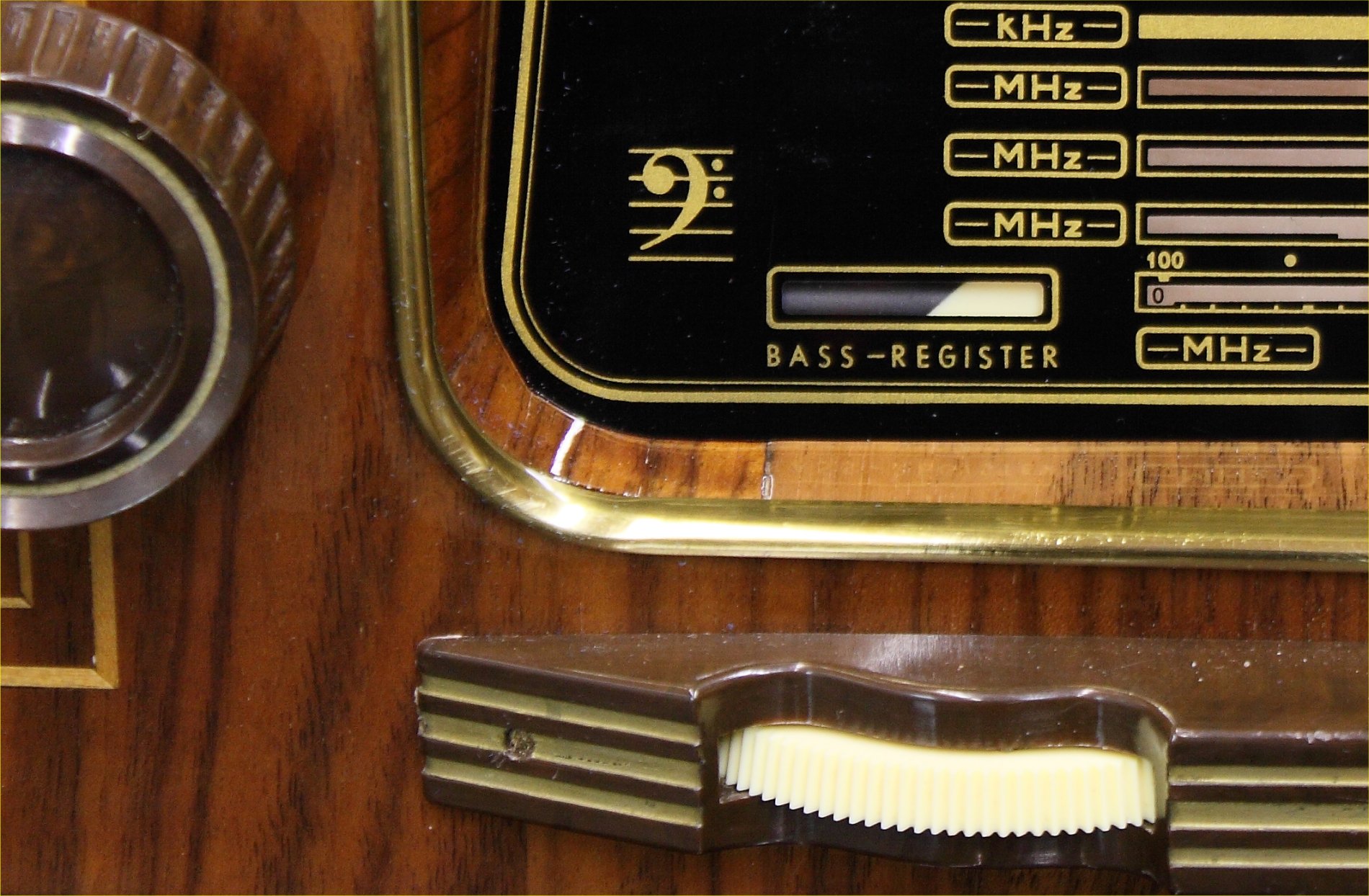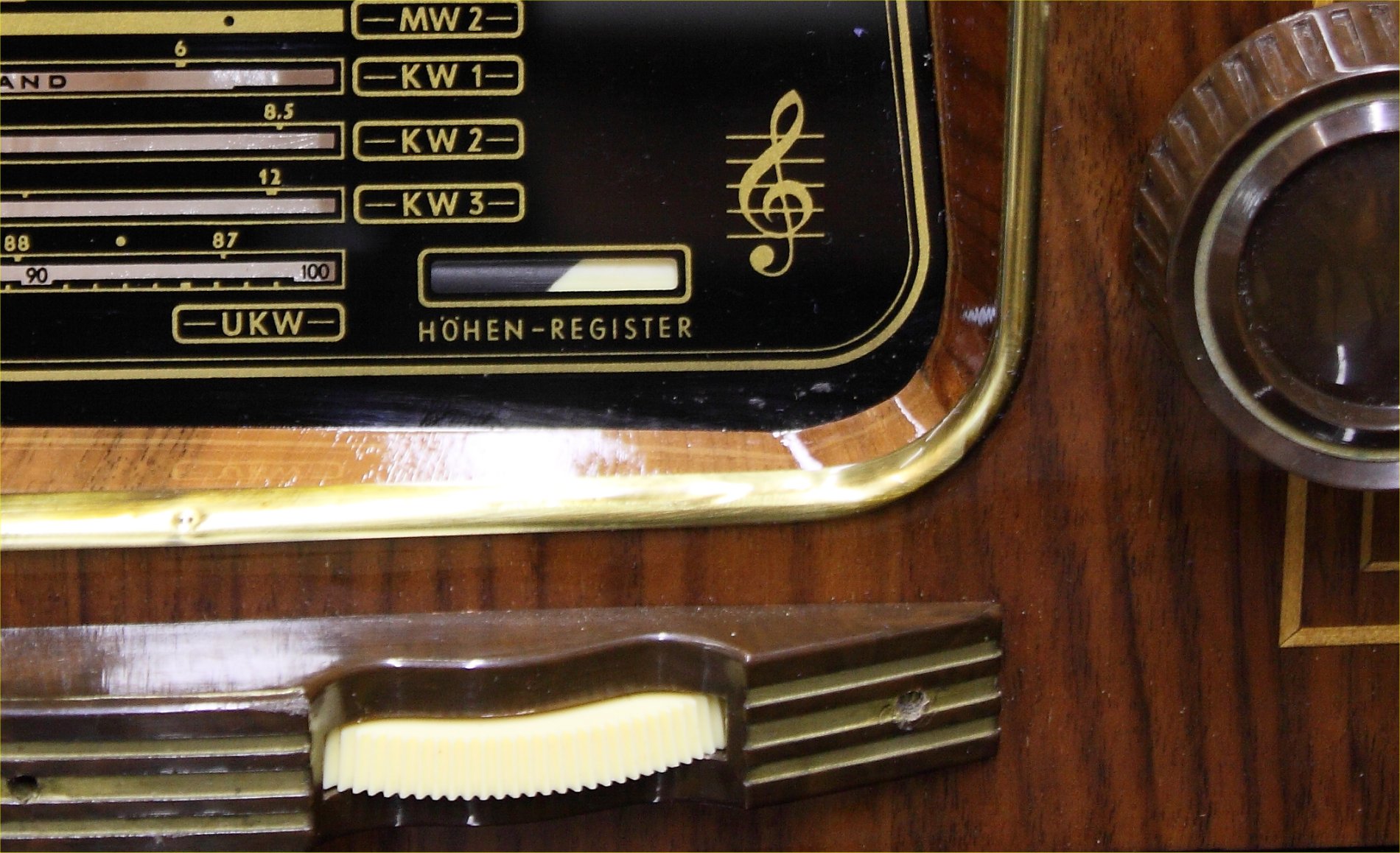 5010 - en
5010 - en
Grundig 5010 – en
- by giovanni
Grundig 5010
Grundig 5010
The Grundig 5010 is the most powerful monaural device ever built by this brand.
Grundig used to produce different classes of devices. Those in the 1xxx series are the cheapest, those in the 2xxx and 3xxx series are middle class, those in the 4xxx and 5xxx series are high class.
Clearly, the 5010 belongs to the higher class series, and it shows.
The electronic circuit of the 5010 is the most elaborate one could imagine in a commercial device built in 1952. The output stage consists of a pair of powerful EL12 push-pulls. No other manufacturer has used of these expensive tubes in a couple.
The output transformers are two, separate, one for the bass and one for the mid-high.
The first is equipped with a double secondary winding, one for the mid-woofer and one for the feedback circuit.
The mid-high transformer is also equipped with a double secondary winding, one for the cone mid-tweeter and one for the electrostatic tweeter.
The crossover consist of capacitors and coil networks. Really remarkable.
The tone controls are applied on the feedback network, further reducing the distortion, but risking instability when the potentiometer are in their extreme positions.
The Push/Pull phase reversal is provided by a dual triode ECC40, where each section drives one of the two EL12s.
The preamplifier is composed of the triode of an EABC80.
The power supply filter consists of a Pi filter of capacitor and inductor.
The FM antenna circuit consists of an EF80 pentode and the local oscillator consists of an EC92 triode.
As it is the only one, the variable capacitor is composed of many sections, for the AM and FM bands.
The tracks chosen for the test are only two. They are quite long as they have not been cut, they have been kept in all their duration. This is because they are both tracks that develop in different ways, alternating moments of pianissimo with areas of big explosion. In the case of the Overture 1812 this last statement must be taken literally.
Binker and Moses have recently emerged in the London jazz scene in the last few years and have the great merit of having aroused in young people an authentic interest in this musical genre, often followed by a more mature audience.
The song “Fete By The River” was recorded live at the Total Refreshment Center in London on June 26th 2017. This excellent recording recreates all the freshness and warmth that are typical of the duo's performances. The video, which is very well done, is also on Youtube, and it is worth seeing.
Drummer Moses Boyd can keep two different rhythms simultaneously, as if there were two drummers playing next to each other.
Binker Golding uses the entire excursion of the saxophone alternating very low and warm notes with disruptive and impressive high-pitched sounds . Binker alternates in a very instinctive way some pianissimo that are almost whispered and explosions of very colorful notes that fill the environment and manage to draw the listeners' attention.
A sequence of syncopated rhythms that has you on the edge of your seat until the end of the track and then bursts into a liberating applause of heartfelt participation.
There is a scent of jazz of the great masters.
The Grundig 5010, with its power and dynamics manages to convey all the expressive capacity of the duo with a realism that makes it hard to believe that it comes from a 1952 radio.
P.I.Tchaikovsky - 1812 Overture: one of the most controversial tracks, but certainly one of the most loved by the public was written to commemorate the Russian success in the battle of Borodinó on September 7th 1812, fought during Napoleon's campaign in Russia.
It was commissioned for the inauguration of the huge Cathedral of Christ the Saviour in Moscow, built by the will of Tsar Alexander I as a memorial for the Russian victory of 1812 over the Napoleonic army.
The overture begins with the orthodox song “Spasi, Gospodi, Lyudi Tvoya” (“God, preserve your people”). It then continues with the popular melody, “U vorot” (“At the gates”). This first part is meant to convey the joy of popular and religious life before the arrival of the Napoleonic troops, represented by the Marseillaise (which however was not used as a national anthem at Napoleon's time).
The decreasing that follows represents the withdrawal of the French troops from Moscow and the arrival of cannon shots marks the military advance of the victorious Russian army. The tolling of bells marks the end of the conflict and the Russian imperial anthem “Bóže, Carjá chraní!” (“God save the Tsar”) is heard in the background (this hymn was not in use at the time either, just like the Marseillaise!).
Even in this very difficult track, the muscles of the 5010 and its excellent speakers have allowed an exciting and distortion-free listening, even at rather high volumes. The engraving is the famous one by Telarc, and you can hear it.
-
BLUETOOTH
Bluetooth receiver embed
-
MULTI PLATFORM CONNECTION
Each radio is equipped with a cable for connection to any digital device.
TUBESOUND IMPROVEMENT
- Bluetooth receiver embed - The unit is equipped with a BLUETOOTH receiver powered directly by the receiver power supply. This makes it possible to control the amplifier from any external digital device as an IPAD, a Smartphone, or a sophisticated multimedia station. So you can hear your preferred web station or your lossesless file without cables on the room. Wireless Receiver can be equipped upon requests.
- Multi Platform Connection - A customized adaptation cable to connect any digital device as Iphone, Smartphone, Laptop, CD Player etc. will be provided with this radio. This special cable suits the different impedances between the modern equipment and the receiver. Furthermore the two stereo channels flow into one without increasing the load to the input unit.
HISTORY
1930 - At 22 years old Max Grundig begin a radio repair business.
1939 - The II world War start. Grundig works primarily for the Wehrmacht and repair of telecommunication equipment.
1945 - Immediately after the war, the demand for repair work was very great. Max Grundig built the first two Grundig appliances: the Tubatest tube tester and the Novatest testing device.
1947 - Start the sale of a kit radio, the Heinzelmann. The unit is the basis of success, sold more than 15,000 pieces.
1950 - Very high frequency (VHF) is introduced to Germany and places new demands on the industry. Grundig launches the 380 W on the market.
1952 - The first television channel starts up in Germany. After intensive research, Grundig launches the FS 080 onto the market. In the same year the first portable tape recorder Reporter 500 L is created.
1956 - After a lot of radio produced with progrssively high performances was produced the Concert Radio 5080 equipped with an equaliser, which has five controls and a visual display.
1965 - A new factory is established in Braga, Portugal. The Satellit 205 is one of many appliances in the Satellit series. This product marks the beginning of Grundig production of high-quality global receivers.
1970 - The Audiorama 7000 Hi-fi was produced, it has twelve dynamic speaker systems in one speaker.
1976 - The Reel Tape Recorder TS 1000 is equipped for semi-professional use.
1980 - The slim-line Hi-fi Tuner ST 6000 and the Monolith Hi-fi Dynamic Flat Top Antenna, which has 22 speaker systems, are two particularly popular appliances in the new hi-fi range.
1984 - After severe drop in sales Philips increased its stake in Grundig 31.6 percent and takes over the corporate management.
1997 - Philips pulls out of its involvement with Grundig.
2003 - The company files for bankruptcy.
2008 - Turkey's Koç Holding took full ownership of Grundig Multimedia B.V., the parent company of Grundig Intermedia GmbH in Nuremberg.
Courtesy of: Grundig
MAIN FEATURES
Year of production: 1952/53
Superheterodyne IF 468/10700
9 AM circuits
10 FM circuits
Wavebands:
Long wave: 150 - 310 KHz
Medium wave 1: 515 - 945 KHz
Medium wave 2: 935 - 1620 KHz
Short wave 1: 5,9 - 8,6 MHz
Short wave 2: 8,6 - 12,5 MHz
Short wave 3: 12,5 - 18 MHz
FM: 86,5 - 100 MHz
Loudspeakers:
1 elliptical wideband
1 electrostatic tweeter
1 elliptical Mid/Tweeter
Dimensions (LHD): 706 x 414 x 305 mm / 27.8 x 16.3 x 12 inch
Net weight: 20 kg / 44 lb 0.8 oz
10 tubes:
EF80 EC92 EF85 ECH81 EM34 EAF42 EABC80 ECC40 2xEL12

TONE CONTROL WITH LEVEL INDICATION
The tones control system is very efficient. Above the large tone control knobs there is a band that lights up gradually indicating the emphasis on the band on which it acts.
Interesting the high-tone control knob linked to two thin ropes. One of them is for the position indicator of the control itself, whereas the other changes the position of the ferrite in the MF transformers modifying the inclination of the transformer’s curve.
By doing so high tones were attenuated/accentuated even before getting to the BF stage. Tone control was usually put into effect with the potentiometer on the voltage amplifier stage
AERIAL
Inside the cabinet there is a dipole for FM reception.
One arm of the dipole is also used for receiving AM bands.
Listening FM band the reception sensitivity with internal aerials is very good.
For AM bands using an external antenna the sensitivity is good.
The picture shows the dipole fixed internally to the cabinet.


TUNING CONTROL
For both AM and FM bands the tuning system is unique.
The single variable capacitor is divided into 4 sections, two for AM and two for FM.
Each section is used respectively for the RF amplifier and the oscillator.
The mechanism is very simple and robust. It has the disadvantage of being a unique command for all bands.
TUNING INDICATOR
The magic eye has of course been replaced.

LOUDSPEAKERS
There are three loudspeakers, all produced by Grundig.
The main wide band measures 13.8 in of width for 7.9 in of height. It covers a part of the radio’s width ..... that is so big.
A very interesting feature is that they are equipped with an adjustable basket.
This allows me to centre the cone movement with respect to the magnetic system.
The electrostatic tweeter is mounted in front of the main wideband. This gives a considerable presence effect to the musical reproduction.
The coaxial lodspeakers allow to locate the position, the depth with respect to the listener, of the various instruments or of the voice with significant precision.
It is a solution that I have always appreciated and that is found in the best radio devices.
The mid-tweeter has an oversized magnet. It has to tolerate considerable power peaks because it is cut very low.
The acute are unexpectedly crystalline whilst remaining very sweet.
The cones are cellulose treated and they are to this day in perfect condition, without any deformation or structural failure.
Objects built when they had to last “at least” the life time of the owner.
On the left you can find the volume control (with incorporated loudness).
Going to the right we find the tuning indicator, it reveal the perfect tuning of each station.
Below there are the bass knob.
By standing on the dialglass we see the Long Waves, the Two Mid Waves, the three Short Waves and the FM band.
The AM scale for Short, Medium, Long waves, and FM.
Finally, you see the treble indicator.
The tuning knob still remains to the extreme right side.
Below the dialglass we find the Bass control:
Then we see the keyboard whose keys have the following purpose respectively:
Power On / Off
Aux, LW, MW1, MW2
SW1, SW2, SW3, FM, MW (stored station)
Finally there is the knob of Treble control.
RESTORING WORKS
5010 AT THE SUNSET IN VENICE - A PHOTO EDITING OF COURSE



































































